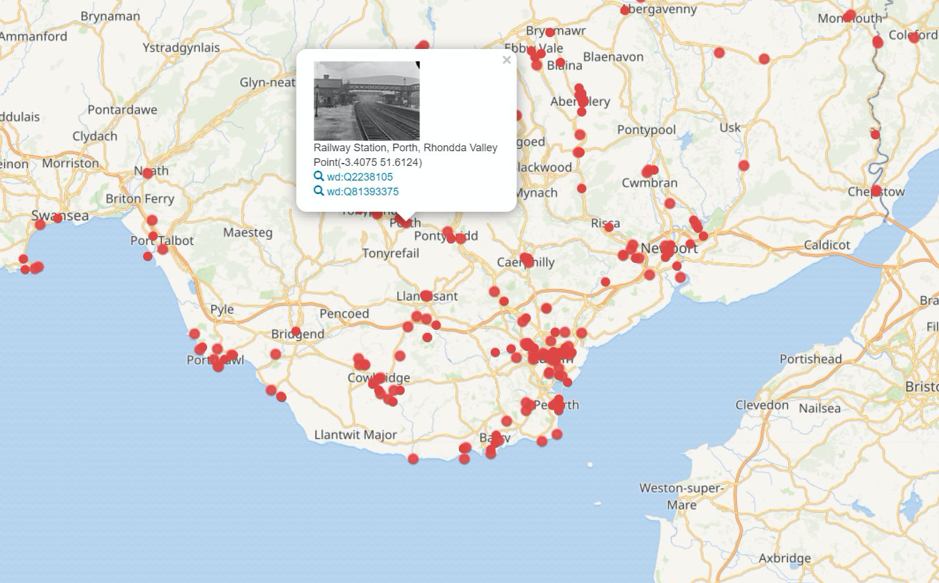Enriching our Collections – The Martin Ridley Collection
Three members of staff from the National Library of Wales share their knowledge and views of Martin Ridley’s photographic collection, which has recently been added to People’s Collection Wales website. These images capture life in Wales in 1905, as seen through the eyes of a commercial photographer from Bournemouth.
William Troughton, National Library of Wales
William shares his story of how the National Library came to acquire this collection and talks about some of his favourite slides:
‘Martin John Ridley was born in 1861 in Reading. Sometime in the 1880s he relinquished his post as a merchant’s clerk, became a professional photographer and moved to Bournemouth. In about 1893, he entered into partnership with Harry Miell to form Miell & Ridley, Bournemouth & Bristol. There is evidence to suggest that Miell concentrated on studio work, Ridley on landscapes, and that the Partnership may not have lasted long. Ridley’s life is not well documented, however, a billhead from 1906 serves as an introduction to his work in the Edwardian era. Among the list of services and goods provided by him as a commercial photographer are Landscape, Marine & Architectural Views, Animal studies, Artists Figures & rustic studies, Christmas, New Year & Birthday Cards, Pictorial Postcards, Book of Views and Stereoscopic Views.
‘This billhead dates from the height of the postcard boom that started a few years earlier and lasted until 1918. As might be expected, Martin Ridley’s collection as a whole contains many views of seafronts, piers, parks and beaches, the staple of any postcard publisher. There are others far removed from what might be expected, e.g. Gwendoline Ward, Cardiff Infirmary, Roath Dock and York Street in Newport.
‘Of particular interest are the views of Abertillery. The reason for a concentration of so many views of Abertillery isn’t known – perhaps for an aborted project, such as a book of views or because he spotted a niche in the market.
‘This is a view of Church Street, Abertillery. Its spontaneous quality is in many ways typical of Ridley. It is an animated commercial street in what was then a prosperous town. To my mind it is true documentary photography, capturing fragments of reality stripped of all cultural intentions. Remember this was taken on a full plate camera mounted on a tripod in full view of all and sundry, yet it achieves spontaneity. There is no escaping the gritty realism in his photography, though there is no indication they were taken with any desire to bring about political and social change.
‘An element of serendipity was responsible for the arrival of the Collection here at the Library. Ridley conducted his business until his death in 1936, due to illness, relying more and more on the help of his daughter, who kept the business going subsequently. By 1964 the premises were to be redeveloped and Bournemouth Echo ran a story of how the remaining 6,000 glass plates (1.5 tons) were to be destroyed. Reading of this, Mrs Mole, a local businesswoman blessed with great foresight negotiated their purchase for £5 and placed them in storage until her retirement in 2007. Since then, the process of sorting has been carried out and suitable institutional homes have been sought for the Collection.’
Jason Evans, National Wikimedian at the National Library of Wales
Jason takes a look Martin Ridley’s urban and industrial images and discusses the potential of this special collection:
‘In the early years of the 20th century, before the onset of war, the Welsh economy boomed, driven by coal and steel. The towns and cities of South Wales rapidly expanded as people flocked to the area for work. The Martin Ridley photographs, taken around 1905, gives us a rare snapshot of this fascinating point in history.
‘Ridley documents the collieries, factories and docks, the railways and tram lines, the rise of vast urban parks and sprawling high streets. He captures the scale of building and development at the time, with new schools, hospitals, churches and libraries springing up everywhere. Some scenes have changed little to this day, but others are unrecognizable, changed beyond all recognition by two world wars, the collapse of industry and the march of progress. The lack of cars (and tarmac) seems slightly odd in scenes which would otherwise not look out of place in the 1940’s or 1950’s. Thankfully the plentiful shots of horses tied up outside shops in city centres remind us that life was very different in 1905.
‘The collections of some 800 images was acquired by the National Library about ten years ago and was recently made available digitally on the Library catalogue. Since the Collection is out of copyright the Library is also able to share the Collection on third party platforms.
‘The Library is thrilled to be sharing these photographs with People's Collection Wales. It’s the perfect platform to really engage people with the Collection, to start discussions, trigger memories and to encourage reuse.
‘The images have also been uploaded to Wikimedia Commons, making them available for use in Wikipedia articles and the catalogue data has been converted to linked open data, making it easier to share and explore. By publishing this data on the Wikidata website we can start to analyse the data using the Wikidata query service.

Most depicted things in the Collection
Wikidata has also helped to enrich the data for the collection by connecting our data with additional external data. So we can do things like fetch coordinates for places that are tagged in the collection. The coordinate data has also been shared with People's Collection so that the images appear on their map viewer.

Places depicted in the Collection on an interactive map
Elena Gruffudd, People’s Collection Wales
In this somewhat surreal world of social distancing that we are living in today, this seaside image by Martin Ridley of children at Tenby beach with St Catherine’s Island in the background offers a welcome breath of fresh air.
I am amazed by how clear Martin Ridley’s images are. They offer us a glimpse of what life was like in Wales over a century ago and you can really see the details on clothing – like the girls’ hats. His photographs take you in, and in an instant you are in the middle of the hustle and bustle of Commercial Street, Newport, side-stepping the people on the pavement. And you can nearly hear the bubbly chat of the women returning from their stroll on Cliff Walk, Penarth.
How did these four children in their Sunday best come to be at Tenby in 1905 – was it a Sunday School trip, or a family picnic perhaps? Ridley has captured more informal gatherings at beaches, such as the image of Penarth beach which creates a great sense of occasion. However, I am drawn back to the children at Tenby beach; frocks have been hitched up and trousers rolled as they stand, pensive, swamped by the sea around them, tide coming in. I cannot help thinking about my children when they were young, never standing still long enough for their photo to be taken on the beach, as they were usually galloping towards the waves, squealing! And here we have these four children, who have ventured carefully to the sea with Martin Ridley’s tripod in the water with them, most likely; what a stark contrast.
Behind them is St Catherine’s Island, which has an interesting history. For many centuries, the only building on the island was a church whose ruins were demolished when the Palmerston Fort was built – seen here in Martin Ridley’s picture. This fortress was completed in the 1870s following orders by Lord Palmerston who was keen to ensure that the Royal Dock Yard in Pembroke Dock and the anchorage at Milford Haven were defended against what was perceived at the time as a real threat from the Emperor Napoleon III of France’s men. At low tide you can walk over to this little island, from Castle Beach – the view from the top of the cliffs towards the colourful port is well worth the climb.
As difficult as it may be at this point to imagine what life will be like when the COVID 19 restrictions are lifted, we will eventually be able to embrace our freedom once again, leave our forts, taste the sea air as we roam beaches in Pembrokeshire and, most important of all, share a smile face-to-face.
Two hundred images from Martin Ridley’s collection have already been shared on People’s Collection Wales website, and a further six hundred images from this enigmatic photographer will be shared with you over the coming weeks and months. If you have a favourite image, leave a comment and let us know.

